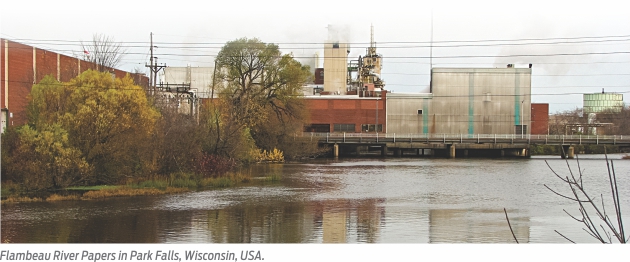Energy expert Richard Reese outlines the energy audit process, and shares strategies identified by mills that have reached their energy reduction goals.
 It is difficult to plan more than a couple of years out when it comes to energy sources. This leaves frustrated mill managers with one solution: use as little energy as possible. Using less energy eliminates other problems such as qualifying for rebates, discounts, or tax breaks. It’s a never-ending exercise—one can go through a mill thoroughly one year and come back two years later and find significant savings again.1
It is difficult to plan more than a couple of years out when it comes to energy sources. This leaves frustrated mill managers with one solution: use as little energy as possible. Using less energy eliminates other problems such as qualifying for rebates, discounts, or tax breaks. It’s a never-ending exercise—one can go through a mill thoroughly one year and come back two years later and find significant savings again.1
All pulp and paper mills offer energy reduction opportunities, but company and mill culture are critical to developing an effective energy reduction program. The best corporate energy programs have excellent management support (including the mill manager), include special capital funds for energy reduction projects, and require solid interdepartmental coordination. Energy auditors can benchmark energy performance and identify energy reduction opportunities, but mill personnel must buy in and make recommended changes.
[table id=2 /]
Taking measurements with portable instrumentation during energy evaluations is important. Use of a portable flow meter during a recent evaluation identified several energy reduction opportunities that operating personnel were not aware of. An example is monitoring cooling water flow and temperatures around paper machine dryer condensers. Steam flow to condensers is often much higher than best practice.Several paper mills in Wisconsin have achieved significant energy use reductions with technical assistance and financial incentives from Focus on Energy and the US Department of Energy. Some paper mills would have shutdown without implementing recommended energy reduction projects. Table 1 shows a few common discoveries during paper machine energy evaluations. Many of the energy reduction opportunities identified are “low hanging fruit” that can be implemented without capital expenditures.
Energy Evaluation Case History
In April 2015, a Wisconsin mill with specialty paper machines completed an energy evaluation. The energy evaluation process included:
- A kickoff meeting to review preliminary information and develop a schedule for the mill visit. The team agreed on a goal of identifying energy reduction projects that would provide more than US$ 500,000 in annual energy savings.
- Completion of paper machine energy scorecards to benchmark energy performance and identify energy reduction opportunities. These scorecards are Excel worksheets with questions related to energy performance, equipment, and operating procedures that affect energy use. Overall energy scorecard scores were 44 percent for one PM and 41 percent for another. The lowest scores were for energy monitoring, the grade scorecard, compressed air, and water systems. (The average score for PMs producing all grades is 50 percent.)
- Review of previous studies of refining, clothing supplier reports, and compressed air system.
- Machine walk-arounds and process measurements with portable instrumentation.
- Working lunches with mill personnel to better understand operating procedures, discuss potential energy reduction projects, and develop a prioritized action list. The action list included 34 projects, including 10 “Priority 1” projects that could be easily implemented; 11 projects that required more time and investigation; and 13 projects that would require more investigation and capital funds.
- An exit meeting to discuss energy benchmarks and recommended energy reduction projects.
- A report summarizing the energy evaluation.
Mill management assigned an energy project coordinator to lead evaluation and implementation of the recommended energy reduction projects. Mill personnel reviewed all of the actions identified in the energy evaluation and implemented most of them.
The actions included four areas that needed more detailed evaluations (a mill water system study, steam and condensate system evaluation, paper machine room air balance, and a vacuum system study.)All four of these studies identified significant energy reduction opportunities that mill personnel decided to implement. Focus on Energy provided incentives to pay one half the costs of all four studies.
Some of the major projects implemented after the energy evaluation included:
- Installed equipment to permit use of filtered whitewater on wet end showers on both paper machines.
- Installed energy-efficient pulper rotors in several stock preparation system pulpers.
- Installed high efficiency side-entry agitators in stock chests.
- Modified the mill compressed air system and lowered system pressure.
- Installed managed differential pressure control on the dryer steam and condensate systems.
In early 2018, the mill conducted a follow-up energy evaluation. Annual energy savings realized since the 2015 audit exceeded the goal of US$ 500,000. The mill has received over US$ 650,000 in Focus on Energy incentive payments since 2013. Energy scorecard scores increased from 44 to 53 percent on one machine, and from 41 to 52 percent on another machine. The biggest improvements were on the compressed air scorecard, agitators and pumps, press sections, and energy monitoring.
The mill recently enrolled in the Focus on Energy Strategic Energy Monitoring program, which will include development of a mill energy model and improvement in energy measurements. The team developed a new energy action list of 36 items during the follow-up energy evaluation. The new actions had few easy-to-implement changes and include some major capital projects. The proactive stance to reduce energy use taken by mill personnel has made the mill more energy-efficient and competitive.
Departmental Interactions
Effective interactions between the paper mill and other mill areas are important to optimize overall mill energy performance. For example, pulp mills usually have excess heat; transfer of heat to the PMs permits reducing team use to heat white water in the paper mill. Interactions with the boiler plant are also important since condensate return from the paper machines and other interactions are important in optimizing team generation cost. A boiler score card was added to paper machine energy score cards in 2016 (see Step 2 of the process above.)
[table id=3 /]
Table 2 shows common discoveries in pulp mill and bleach plant energy evaluations; Table 3 shows common opportunities found in boiler audits; and Tables 4A and B list opportunities found in power generation audits.
[table id=4 /]
Catherine DeVyre, an Australian business consultant, has stated, “The six most expensive words in business are ‘We’ve always done it that way’.” This adage certainly applies in pulp and paper mills.
There are many myths related to energy use in pulp and paper mills that are sustained year after year. Many of these misunderstandings actually make it easier to find energy reduction opportunities in pulp and paper mills. (Reference 5 has a long list of pulp and paper mill energy myths.)
New Technologies
The Focus on Energy pulp and paper team continuously tracks new technologies that have potential to reduce energy use in pulp and paper mills. New technologies are considered emerging technologies if they have not been installed on more than ten percent of potential applications in Wisconsin and have potential application to reduce energy consumption in several pulp and paper mills.
[table id=5 /]
Some of the new technologies that have been successfully implemented in Wisconsin pulp and paper mills since 2014 are:
- Disk refiner upgrades with splined rotors
- Energy-efficient pulper rotors and extraction plates
- Kadant high efficiency thermo compressors
- Voith HydroSeal suction roll seal systems
- Kadant RotoFlex white water strainers
- Mechanical seals on rotating equipment with tanks to circulate seal water
- Compressed air systems with VFD and regenerative dryers
The goal is to evaluate these technologies and install successful technologies in other pulp and paper mills so they become energy best practices. Special incentives are offered to encourage installation of new technologies.
[table id=6 /]
North Carolina State University developed and maintains a website that tracks energy policies and incentive programs in the United States: www.dsireusa.org. Energy programs and incentives can be accessed by entering the zip code of pulp and paper mill sites. While the Focus on Energy program only provides incentives for Wisconsin participating utility customers, the pulp and paper team is available for energy evaluations in other states.
Conclusion
There are opportunities to reduce energy use in all pulp and paper mills. Energy use varies widely between mills producing similar grades. The guidelines and suggestions in this article can help mills benchmark energy consumption and identify improvement opportunities.
Mill operating personnel often do not fully understand process interactions and their impact on energy consumption. Focused energy evaluations can identify operating changes and capital projects with fast payback to reduce energy use.
Authored by Richard Reese and originally published in the July/August issue of Paper360. Richard Reese is a paper machine energy subject matter expert with Wisconsin’s Focus on Energy program. His industry career has spanned more than five decades, and in 2011 he was awarded TAPPI’s Gunnar Nicholson Gold Medal, which recognizes preeminent scientific and engineering achievements.
References:
- Nip Impressions, Week of May 7, 2018.
- TAPPI TIP 0404-63 (2016), paper machine energy conservation.
- Reese, Dick and Hasbargen, Tim, “Paper Machine Energy Best Practices”, TAPPI PaperCon 2017, Minneapolis, April, 2017.
- TAPPI TIP 0416-24, pulp mill energy checklist.
- Reese,Richard,and Deodar, Subhash, “Using Common Sense and Emerging Technologies to Reduce Energy Use”, TAPPI PaperCon 2018, Charlotte, NC April 2018.



